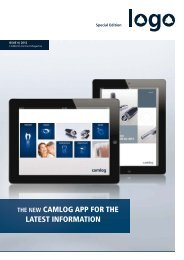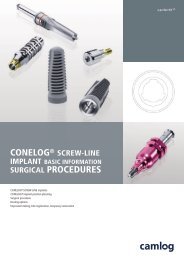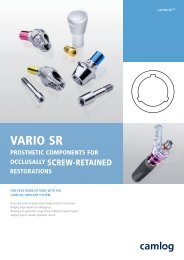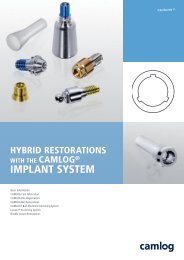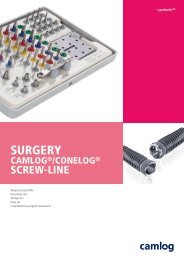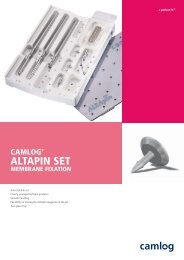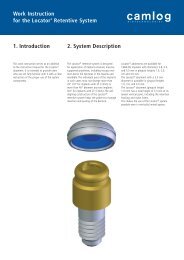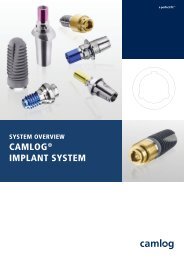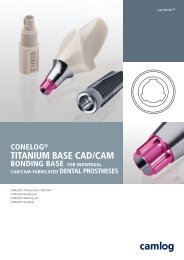CONELOG® Implant System Prosthetic Restorations - Camlog
CONELOG® Implant System Prosthetic Restorations - Camlog
CONELOG® Implant System Prosthetic Restorations - Camlog
Create successful ePaper yourself
Turn your PDF publications into a flip-book with our unique Google optimized e-Paper software.
CONELOG ® IMPLANT SYSTEM<br />
PROSTHETIC RESTORATIONS<br />
CONELOG ®<br />
BAR ABUTMENT<br />
EMBEDDING, CAST AND DEVESTMENT<br />
The abutment is embedded according to the instruction manual of the muffle<br />
system used. We do not recommend the use of wax wetting agents.<br />
However, if wax wetting agents are used, it must be suitable for use with<br />
POM plastic components. When embedding, the correct placement of the<br />
wax-up in the casting muffle is of importance. Volume ratios and pin angles<br />
must be selected so that the required temperature for casting is<br />
achieved. This is particularly important for voluminous casts. We recommend<br />
phosphate bound investment materials. The manufacturer's processing<br />
instructions must be observed and the mixing ratios and preheating<br />
times accurately observed. We recommend you do not use any quick heating<br />
processes (speed investment materials). The cast delay time must be<br />
kept as brief as possible.<br />
After casting, the cast object must be slowly cooled to room temperature<br />
and the object gently devested. We recommend gentle devestment in an<br />
ultrasonic bath with waterjet or stripping.<br />
After casting, suitable reworking reamers are available to remove/smooth<br />
out casting residues for reworking the screw seat and the shoulder contact<br />
area to the CONELOG ® bar abutment.<br />
After trimming the bar, it is checked for a precision fit. Good hygiene capacity<br />
must be ensured. A distance of min. 2 mm to the gingiva must be<br />
maintained to prevent insufficient cleaning and associated changes to the<br />
mucous membrane.<br />
The secondary framework, e.g. electroplating technique, is then fabricated.<br />
INSERTING THE BAR CONSTRUCTION<br />
The CONELOG ® bar abutments are transferred from the working cast to<br />
the CONELOG ® implants and screwed in definitely with the prescribed<br />
torque. The finished bar construction is transferred to the CONELOG ® bar<br />
abutments and fixed definitely with 15 Ncm with new unused prosthetic<br />
screws, using a screwdriver (hex). The newly created full denture is then<br />
inserted and checked for proper fit.<br />
112<br />
Reworking reamer, for base for<br />
bar abutment, for the screw seat<br />
Ø 3.3/3.8/4.3/5.0 mm<br />
Reworking reamer, for base for<br />
bar abutment, for the plane surface/<br />
cone seat Ø 3.3/3.8/4.3/5.0 mm<br />
Example: Milled bar construction<br />
Example: Milled bar construction with<br />
secondary framework using the electroplating<br />
technique and tertiary structure<br />
Cast bar<br />
Cast bar<br />
base<br />
Cast bar<br />
Cast bar<br />
base<br />
Reaming out the screw channel<br />
of the cast bar base<br />
Reaming out the inner cone and<br />
plane surface of the cast bar base



